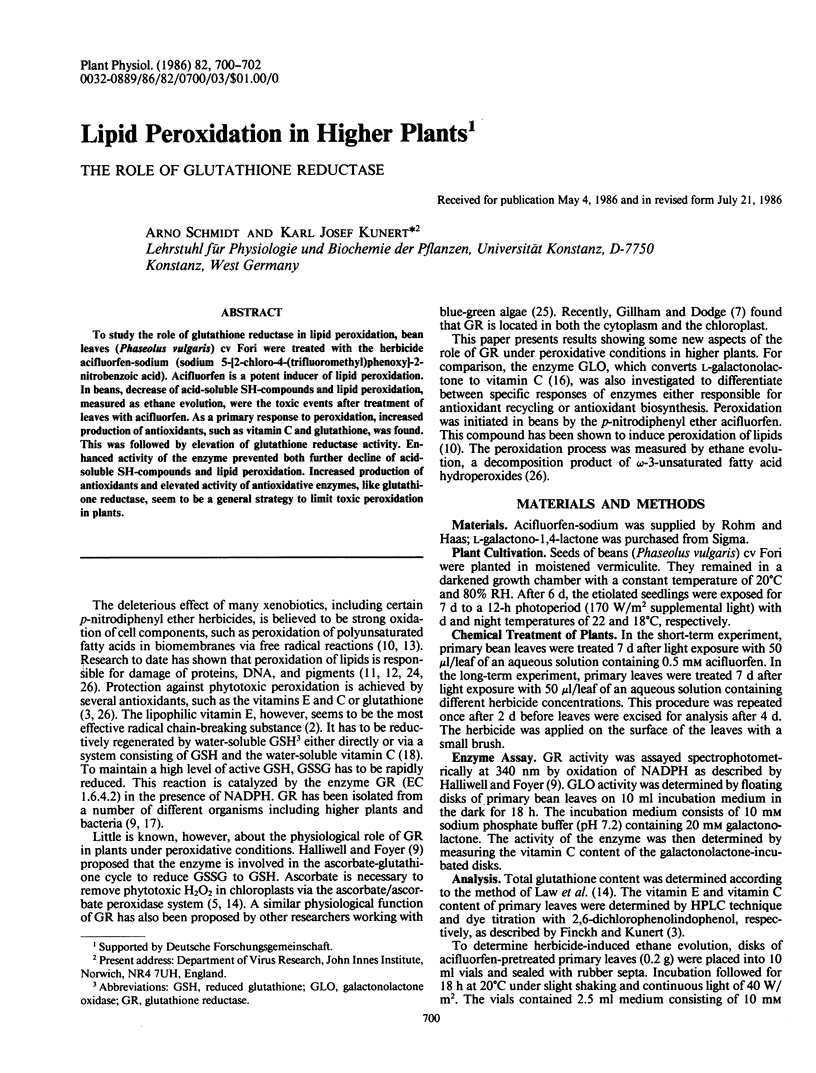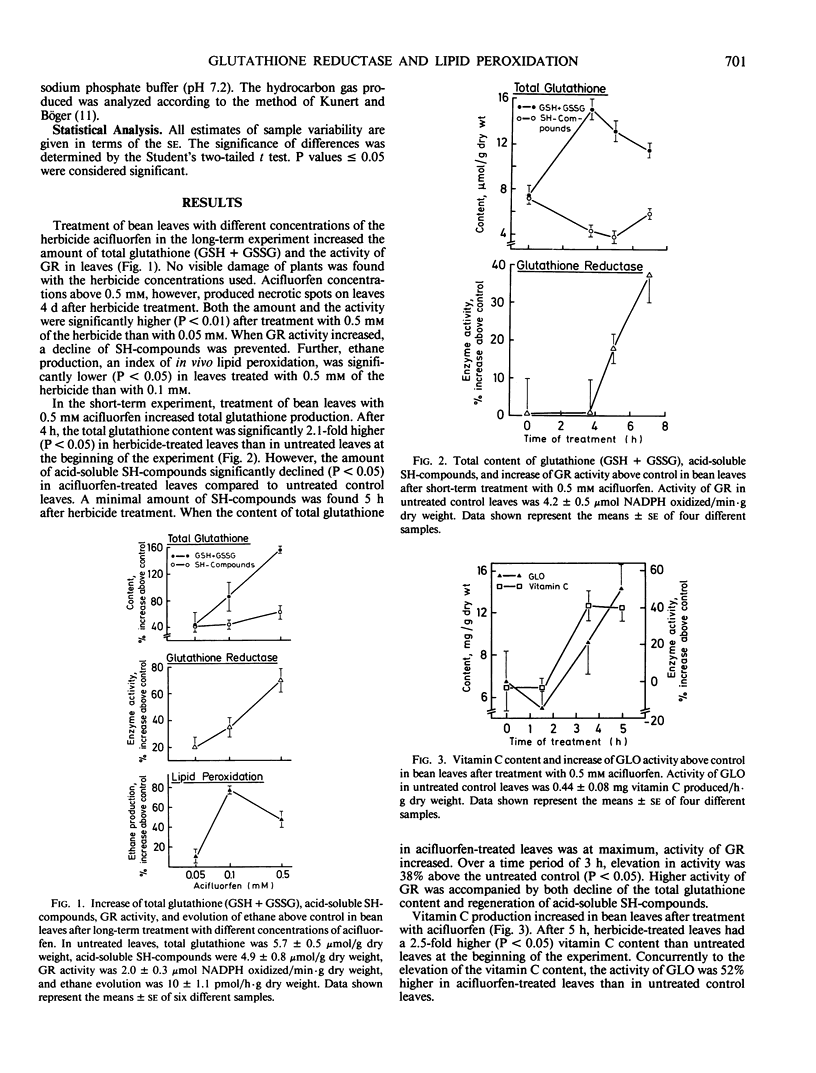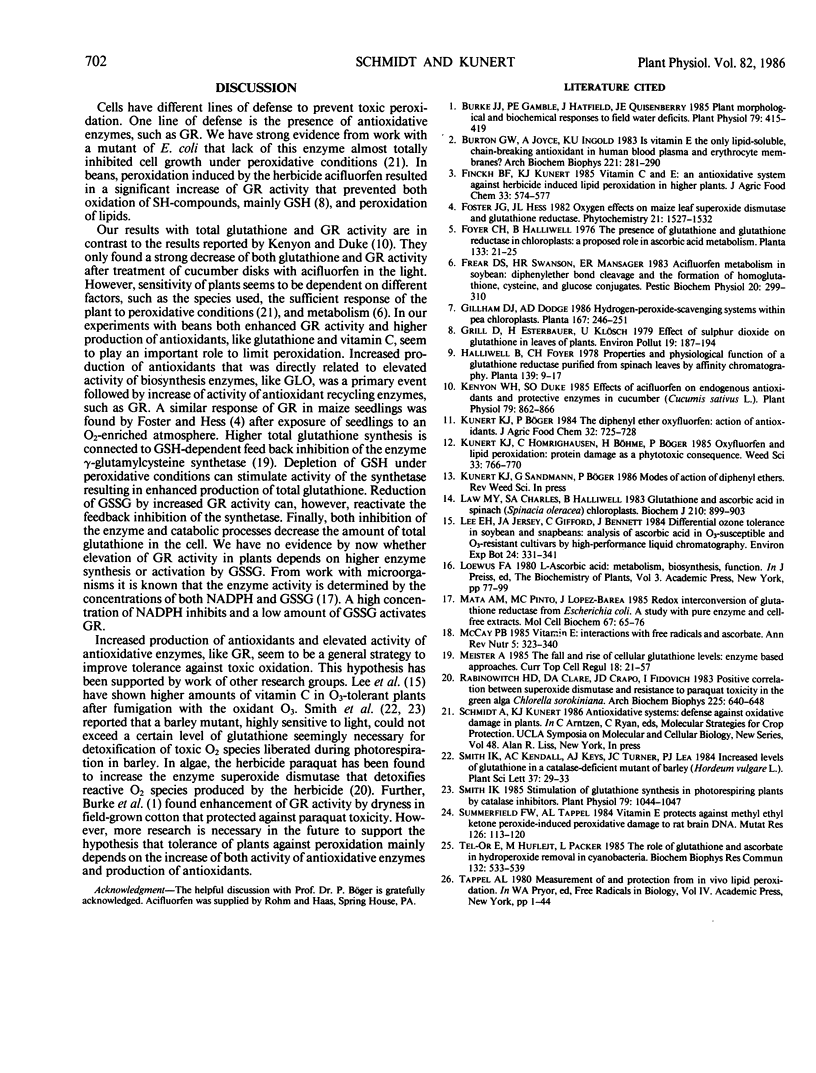Abstract
To study the role of glutathione reductase in lipid peroxidation, bean leaves (Phaseolus vulgaris) cv Fori were treated with the herbicide acifluorfen-sodium (sodium 5-[2-chloro-4-(trifluoromethyl)phenoxy]-2-nitrobenzoic acid). Acifluorfen is a potent inducer of lipid peroxidation. In beans, decrease of acid-soluble SH-compounds and lipid peroxidation, measured as ethane evolution, were the toxic events after treatment of leaves with acifluorfen. As a primary response to peroxidation, increased production of antioxidants, such as vitamin C and glutathione, was found. This was followed by elevation of glutathione reductase activity. Enhanced activity of the enzyme prevented both further decline of acid-soluble SH-compounds and lipid peroxidation. Increased production of antioxidants and elevated activity of antioxidative enzymes, like glutathione reductase, seem to be a general strategy to limit toxic peroxidation in plants.
Full text
PDF


Selected References
These references are in PubMed. This may not be the complete list of references from this article.
- Burke J. J., Gamble P. E., Hatfield J. L., Quisenberry J. E. Plant morphological and biochemical responses to field water deficits: I. Responses of glutathione reductase activity and paraquat sensitivity. Plant Physiol. 1985 Oct;79(2):415–419. doi: 10.1104/pp.79.2.415. [DOI] [PMC free article] [PubMed] [Google Scholar]
- Burton G. W., Joyce A., Ingold K. U. Is vitamin E the only lipid-soluble, chain-breaking antioxidant in human blood plasma and erythrocyte membranes? Arch Biochem Biophys. 1983 Feb 15;221(1):281–290. doi: 10.1016/0003-9861(83)90145-5. [DOI] [PubMed] [Google Scholar]
- Kenyon W. H., Duke S. O. Effects of Acifluorfen on Endogenous Antioxidants and Protective Enzymes in Cucumber (Cucumis sativus L.) Cotyledons. Plant Physiol. 1985 Nov;79(3):862–866. doi: 10.1104/pp.79.3.862. [DOI] [PMC free article] [PubMed] [Google Scholar]
- Law M. Y., Charles S. A., Halliwell B. Glutathione and ascorbic acid in spinach (Spinacia oleracea) chloroplasts. The effect of hydrogen peroxide and of Paraquat. Biochem J. 1983 Mar 15;210(3):899–903. doi: 10.1042/bj2100899. [DOI] [PMC free article] [PubMed] [Google Scholar]
- Mata A. M., Pinto M. C., López-Barea J. Redox interconversion of glutathione reductase from Escherichia coli. A study with pure enzyme and cell-free extracts. Mol Cell Biochem. 1985 May;67(1):65–76. doi: 10.1007/BF00220987. [DOI] [PubMed] [Google Scholar]
- McCay P. B. Vitamin E: interactions with free radicals and ascorbate. Annu Rev Nutr. 1985;5:323–340. doi: 10.1146/annurev.nu.05.070185.001543. [DOI] [PubMed] [Google Scholar]
- Rabinowitch H. D., Clare D. A., Crapo J. D., Fridovich I. Positive correlation between superoxide dismutase and resistance to paraquat toxicity in the green alga Chlorella sorokiniana. Arch Biochem Biophys. 1983 Sep;225(2):640–648. doi: 10.1016/0003-9861(83)90075-9. [DOI] [PubMed] [Google Scholar]
- Smith I. K. Stimulation of glutathione synthesis in photorespiring plants by catalase inhibitors. Plant Physiol. 1985 Dec;79(4):1044–1047. doi: 10.1104/pp.79.4.1044. [DOI] [PMC free article] [PubMed] [Google Scholar]
- Summerfield F. W., Tappel A. L. Vitamin E protects against methyl ethyl ketone peroxide-induced peroxidative damage to rat brain DNA. Mutat Res. 1984 Apr;126(2):113–120. doi: 10.1016/0027-5107(84)90052-6. [DOI] [PubMed] [Google Scholar]
- Tel-Or E., Huflejt M., Packer L. The role of glutathione and ascorbate in hydroperoxide removal in cyanobacteria. Biochem Biophys Res Commun. 1985 Oct 30;132(2):533–539. doi: 10.1016/0006-291x(85)91166-0. [DOI] [PubMed] [Google Scholar]


